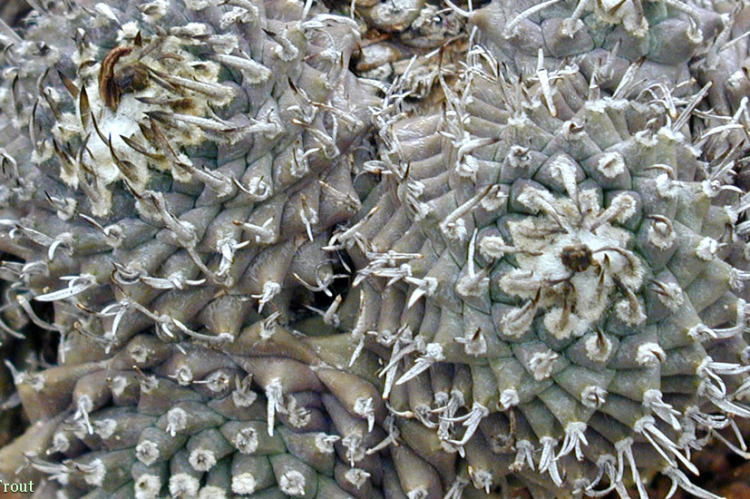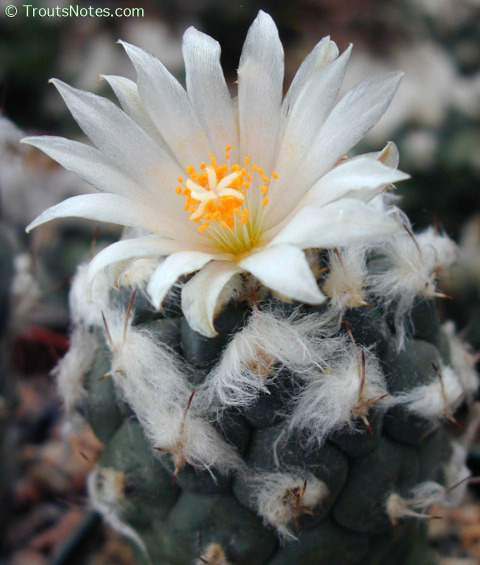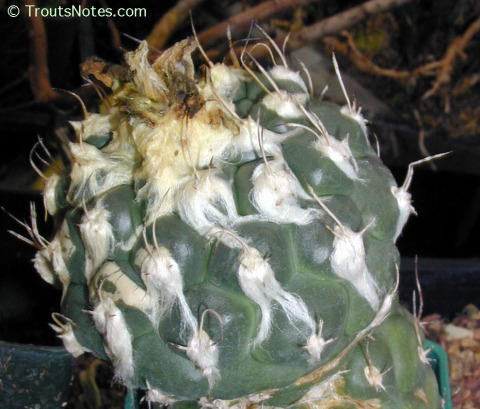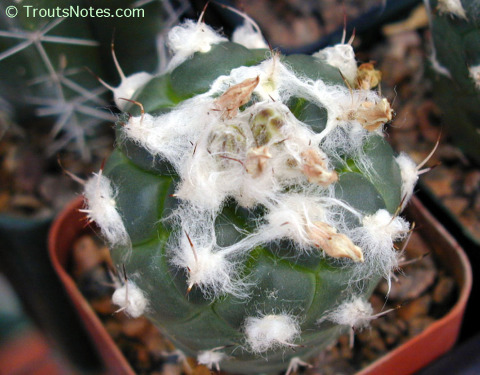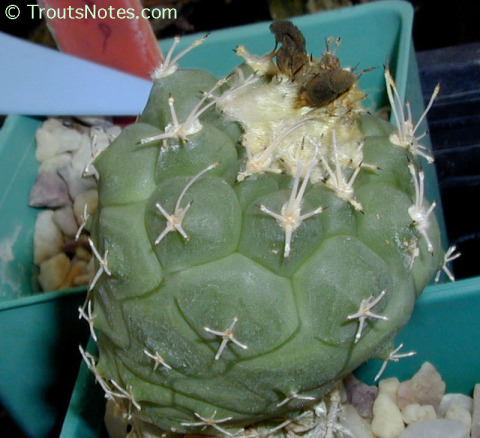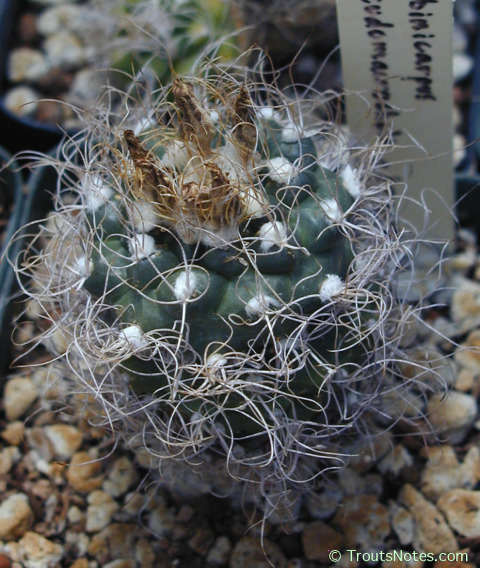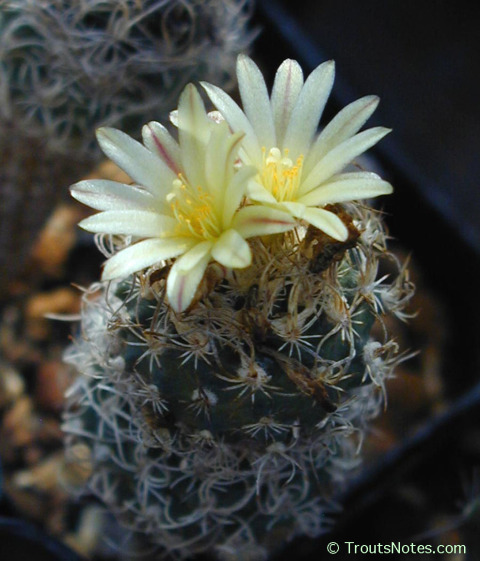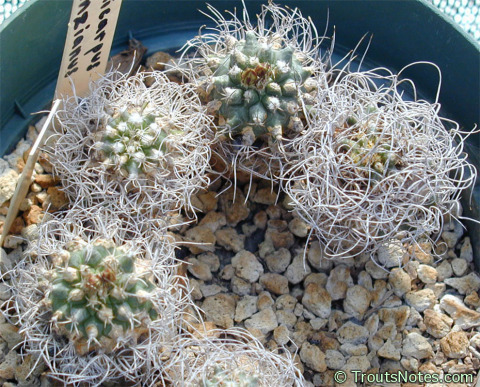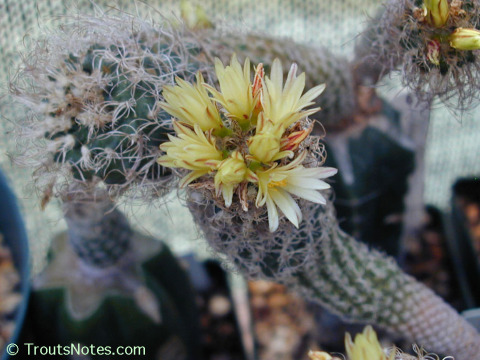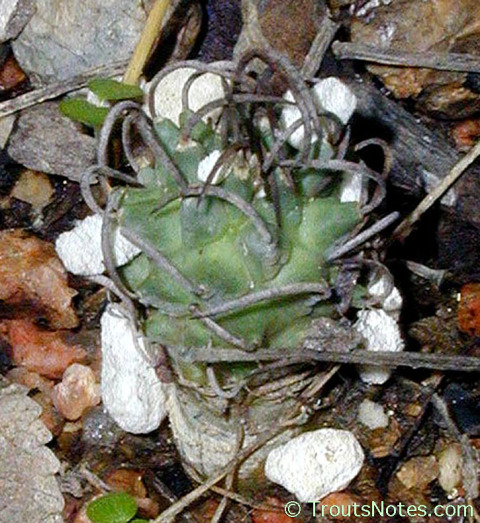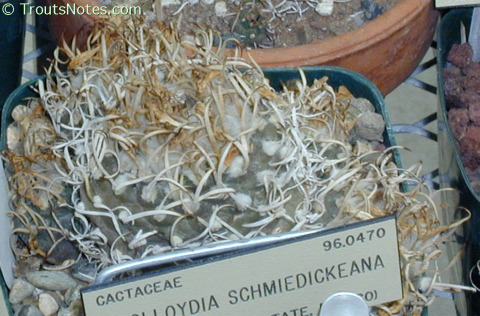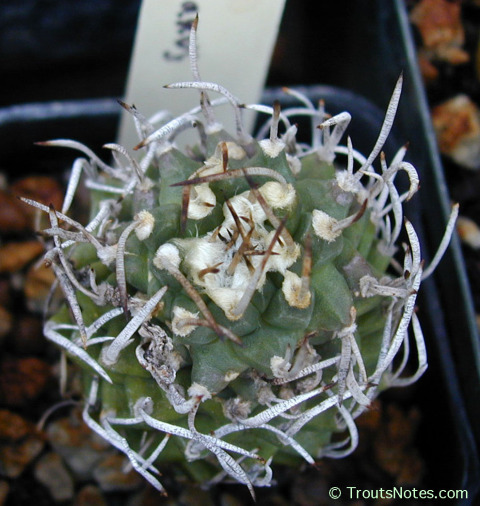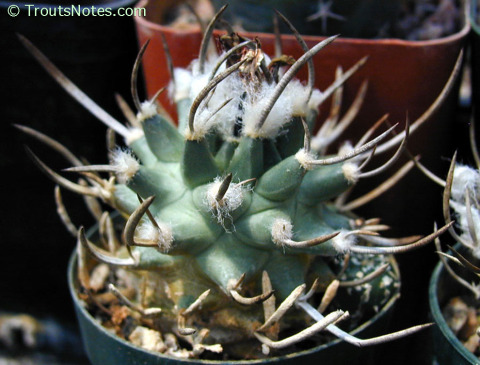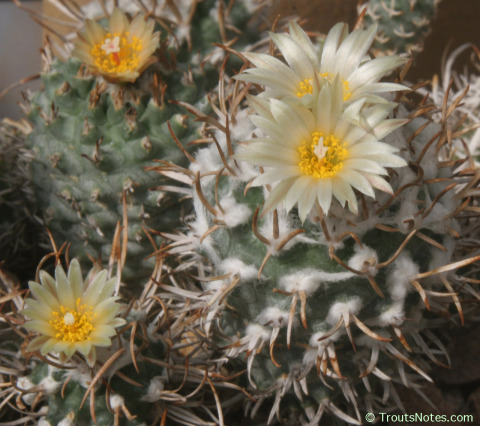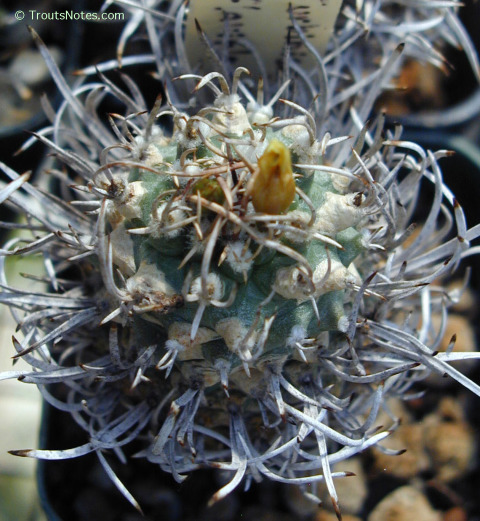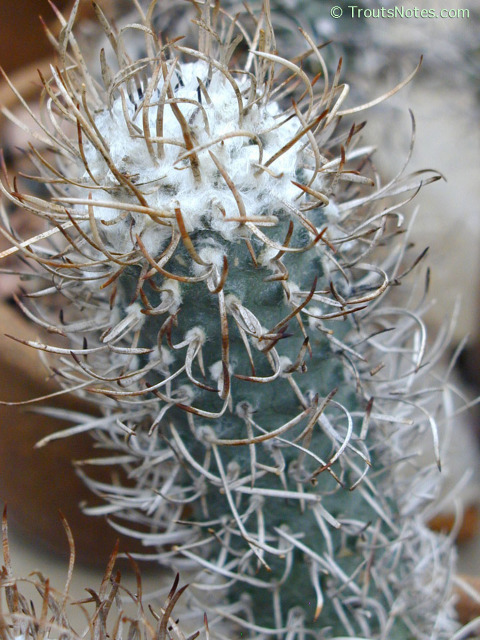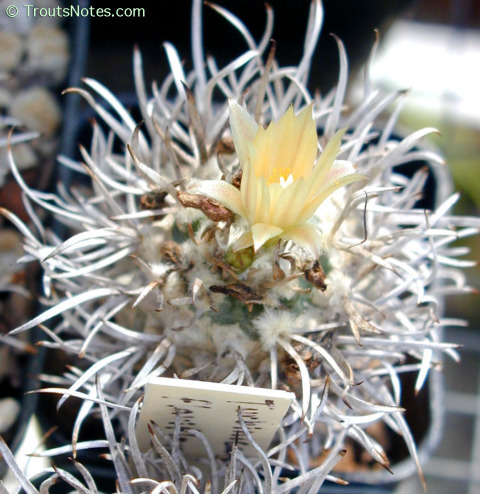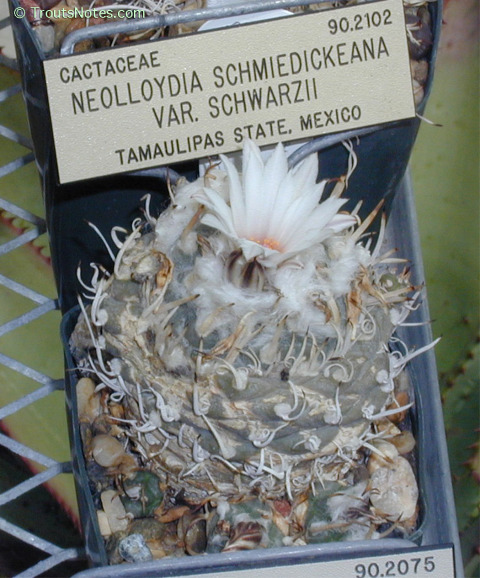The Turbinicarpus species
These plants are miniature cacti occurring in the Mexican Chihuahuan Desert.
They are often grafted to produce faster growth and increased offsets for propagation. Grafting similarly increases the rate and occurrence of flowering.
Extremely easy to grow from seed. Ready sets viable seed even in cultivation or in grafted plants.
Fruit dehisces via a single longitudinal split.
The dull colored fruit are said to not be attractive to birds and other animals that could help spread seeds.
Distribution is apparently via ants, wind and water; producing a limited range for these tiny plants.
Many different collection numbers exist in horticulture.
They are very popular among cactus collectors due to their small adult size, free flowering and generally overall wonderful appearance.
So much so that some have been entirely wiped out of their native habitat to fill the demand of collectors.
In at least one case where a new species was described, its extremely limited native habitat was immediately collected down to the last locateable plant by commercial European cactus collectors. All were apparently shipped elsewhere for resale to collectors who value possessing very rare plants.
They are EASY to grow from seed.
The published names have included not just several other genera (Echinocactus, Neolloydia, Pediocactus, Strombocatus, Thelocactus & Toumeya) but they have also been variously reshuffled as varieties and subspecies of each other.
Lining up the actual species that were tested by Štarha with what is recognized as those species may not be accurate due to those repeated revisions. In those areas with discrepancies it is best to weight in on the side of European views rather than those coming from authors in the USA as Štarha relied on European seed sources for producing his material.
All Turbinicarpus species analyzed by Dr. Štarha were seed grown in Czechoslovakian greenhouses.
Etymology:
Turbinicarpus was named for its top-like fruit (“turbinate“) It is a “bastard” word combining the Latin word “turbineus“, meaning “top“, with the Greek word for fruit “karpos“.
Echinocactus was named for being perceived of as resembling a hedgehog. From the Greek words echinos (hedgehog) and kaktus (thistle or artichoke).
Neolloydia was named after the botanist Francis Ernest Lloyd (4 October 1868 – 10 October 1947).
Pediocactus was derived from the Greek word pedion referring to its habitat being on the “plains“.
Strombocactus is from the Greek word strombos meaning “fir-cone” or “a spinning top” or “shell-shaped” in reference to its shape.
Thelocactus came from the Greek word thelo meaning “wart” or “nipple” referring to the sharply defined and pronounced tubercles.
Toumeya was coined to honor Dean James W. Toumey of New Mexico.
“Biznaguita” can be found given online, without a reference, as a common name for a number of the Turbinicarpus species but I cannot locate any primary source confirming that or, if so, which species it actually refers to. Biznaguita appears to be a generic word that is the diminutive of biznaga so it may be a general term similar to the word biznaga.
Turbinicarpus lophophoroides (Werdermann) Buxbaum & Backeberg
Franz Buxbaum & Curt Backeberg (1937) Jahrbuch der Deutschen Kakteen-Gesellschaft in der Deutschen Gesellschaft für Gartenkultur, 1: 27 (this refers to the article number – there are NO page numbers in this journal.), as Turbinicarpus lophophoroides.
Also as:
F.M. Knuth (1936) Kaktus-ABC, 356. (Strombocactus lophophoroides)
W.T. Marshall (1946) Cactus (Paris), 4: 5 & (1947) Cactus & Succulent Journal (USA), 19: 77. (Toumeya lophophoroides)
Mescaline reported as traces.
Etymology: Named due to having a general resemblance to Lophophora.
Distribution & occurrence: 200 m; Las Tablas, San Luís Potosí, México (Backeberg 1977).
Habitat: “Occurs in silty, limestone soil in dry patches in semi-swampy country where in the dry season it pulls down into the ground and is occasionally completely covered by soil” (Glass & Foster 1977).
Original description:
“Simplex (ut videtur), ± hemisphaericus, ca. 2,5–3,5 cm altus et 4–4,5 cm diam., vertice dense lana albida clausus atque nonnullis aculeis laxe dispositis superatus. Costae in tuberculas 4–6 angulare, ± applanatas dissolutae. Areolae oblongae, primum breviter floccosae, dein glabrescentes. Aculei radiales 2–4, horizontaliter divaricati, ca. 4–8 mm longi, aciculares vel subsubuliformes, centralis 1, crassior, ad 1 cm longus, erectus et apicem versus incurvatus, omnes subnigri vel grisei, laeves vel subasperi. Flores e lana verticis, aperti ca. 3,5 cm diam., subalbidi. Ovarium atque tubus pallide viridia et glabra. Phylla perigonii interiora ad 2 cm longa et 4 mm lata, subacuta, albida. Filamenta fere albida. Stylus ca. 1–1,2 cm longus, albidus, stigmatibus 4, albidis multum brevior quam stamina longissima.” p. 176 in Werdermann 1934.
Generally these occur as single plants. There is a “fairly stout” taproot, Backeberg 1977.
Bluish-green (Backeberg 1977) glaucous greyish-blue to bluish-green (Glass & Foster) dull grey- or more dark green (Werdermann) Body is depressed-hemispherical (Backeberg 1977) depressed globose to flattened (Glass & Foster) rather depressed hemispherical or somewhat more conical (Werdermann), and can reach 3.5 cm high and 4.5 cm in diameter.
The crown of the plant is concealed by abundant dense, white to silvery-grey, wool or hair which is pierced through by the slightly curved spines (Backeberg & Werdermann). Grafted plants offset more freely than when on their own roots (Backeberg 1977). Anderson 1998 described stems as often being clublike and up to 2 inches wide and 4 inches tall with age.
Ribs consist of loosely packed (Werdermann) fairly flattened-rounded tubercles arranged in a spiral. They are “4-6 sided below” (Backeberg 1977), “more or less 6 angled at base, 2-4 mm high, slightly rounded, more or less 4 angled” (Glass & Foster 1977), and up to 12 mm across. They are often more or less confluent below in grafted plants (Backeberg 1977).
Areoles are somewhat elongated. They are 2.5 mm long (Glass & Foster 1977), longitudinally stretched, about 2 to 2.5 mm long, white wool when young, soon becoming bare (Werdermann).
2 or 3 (to 4) straight erect spines to 8 mm in length. One is more central than the rest and can reach 1 cm. [straight, erect to incurved, Glass & Foster]. Spines begin black or white tipped with black (Backeberg 1977). All are smooth, stiff grey to blackish or whitish with darker upper portion, slightly recurved (Glass & Foster 1977).
Whitish flower is tinged with a delicate pink color. More so towards the center and middle of the petal (Backeberg 1977). Flowers 3.5 cm wide, tube 5 mm long, slender, pale greenish, smooth; outer perianth segments 1 cm long, 2.5 mm broad, pale yellowish green to brownish olive with pale, rounded margins; inner segments 2 cm long, 4 mm broad, white to pinkish” (Glass & Foster 1977). Light pink 1.25 inch in diameter flowers several times during the summer, Anderson 1998.
Style and 4 stigma lobes whitish (Glass & Foster 1977).
Anthers: orange yellow (Glass & Foster 1977).
Pericarp: 2-3 mm in diameter (Glass & Foster 1977).
Fruit is light green (Backeberg 1977); “occasionally with traces of vestigal scales” (Glass & Foster 1977).
Seeds are small and black.
Description adapted from:
Backeberg 1977; pages 500-501.
Glass & Foster 1977: page 171.
Werdermann 1934
EM seed photo on page 170; fig. 43 of Glass & Foster 1977.
Photo on page 165; fig 13 and page 171; fig. 53 (flowering).
Photo with flowers: page 114 of Anderson 1998.
Turbinicarpus web site: http://www.mfaint.demon.co.uk/cactus/turbo/desc/lophophoroides.html includes photo of plant, flowers & seedling.
Miles Anderson describes it as being rot prone and requiring warm nights for growth during summer.
Anderson adds that it can handle 20°F for brief periods.
Reported chemistry:
Phenethylamine (1.04% [± 0.27] of total alkaloid fraction of over 500 mg total alkaloids per 100 gm of fresh plant)
Tyramine (1.82% [± 0.17] of total alkaloid fraction of over 500 mg total alkaloids per 100 gm of fresh plant)
N-Methyltyramine (0.13% [± 0.11] of total alkaloid fraction of over 500 mg total alkaloids/ 100 gm of fresh)
Hordenine (91.69% [± 0.54] of total alkaloid fraction of over 500 mg total alkaloids per 100 gm of fresh plant)
Mescaline (Trace detected)
N-Methylmescaline (0.51% [± 0.11] of total alkaloid fraction of over 500 mg total alkaloids/ 100 gm of fresh)
N,N-Dimethylmescaline (Trace detected)
O-Methylanhalidine (0.55% [± 0.02] of total alkaloid fraction of over 500 mg total alkaloids/ 100 gm of fresh)
Anhalinine (0.15% [± 0.08] of total alkaloid fraction of over 500 mg total alkaloids per 100 gm of fresh plant)
Anhalonidine (2.37% [± 0.12] of total alkaloid fraction of over 500 mg total alkaloids per 100 gm of fresh plant)
Pellotine (0.46% [± 0.08] of total alkaloid fraction of over 500 mg total alkaloids per 100 gm of fresh plant)
Štarha et al. 1999
Turbinicarpus pseudomacrochele (Backeberg) F.Buxbaum & Backeberg
Reported chemistry:
Hordenine (Sole alkaloid. 1-10 mg of total alkaloids/ 100 gm.
fresh.) Bruhn & Bruhn 1973
Turbinicarpus pseudomacrochele var. krainzianus (Frank) Glass & Foster
Gordon D. Rowley (1974) Repertorium Plantarum Succulentarum, 8 (1972): 10 (Strombocactus pseudomacrochele var. krainzianus)
Leo Kladiwa (In Hans Krainz) (1966) Kakteen, 34: C 8 (Toumeya pseudomacrochele var. krainziana)Several additional names have appeared; those are being omitted.
Mescaline reported as traces.
Etymology: Named for Hans Krainz.
Distribution & occurrence: Mexico (It was described some 25 years after being discovered) Backeberg 1977. Glass & Foster 1977 give the distribution as “unknown, but presumed to occur in Queretaro or Hidalgo.”
Original description:
[INSERTION STILL NEEDED]
Dark green stem is short and cylindrical. Occasionally multiheaded (Backeberg 1977). [Anderson 1998 states that it “tends to offset heavily” and forms clumps up to 6 inches across.] Heads can reach 4 cm tall and 3 cm wide (Backeberg 1977), 2-3.5 cm in diameter, 3-4 cm long (Glass & Foster 1977) [1.5 inch wide: Anderson 1998]
The crown bears white wool.
11 ribs divided into tubercles are set in spirals. The tubercles are conical above and rhomboid below.
Areoles are white and wooly. They become naked with age (Glass & Foster 1977).
6-8 flexible spines, 12-30 mm long, are more or less twisted
(tortuous). They start yellow-brown becoming grey and dark tipped and eventually drop off. [The upper spine is longest according to Glass & Foster.]
Slender funnelform flowers from apex, (Glass & Foster 1977).
Creamy yellow flower is greenish cream outside. (Backeberg 1977) Outer perianth segments are greenish with the inner segments [the petals] greenish to yellowish cream colored (Glass & Foster 1977). Flower can reach 2 cm in length.
5/8th inch in diameter flowers in flushes; several times during summer, Anderson 1998.
Pericarp is green (Glass & Foster 1977).
Style is white with 4 white stigma lobes (Glass & Foster 1977).Ovate to globose fruit is 3-5 mm in diameter. Starts green later becomes reddish (Glass & Foster 1977).
Black seeds are 1 mm long with finely tuberculate testa (Glass & Foster 1977).
Description adapted from:
Backeberg 1961: p. 2890. Photo flowering in fig. 2721.
Backeberg 1977: page 500.
Glass & Foster 1977: page 173. Photo on page 165; fig. 16 and page 173; fig. 58 (flowering).
Photo with flowers: page 114 of Anderson 1998
Miles Anderson describes it as being rot prone and needing a coarse compost.
He adds that it can handle 25°F for brief periods.
Reported chemistry:
Phenethylamine (1.12% [± 0.13] of total alkaloid fraction of 250-500 mg total alkaloids per 100 gm of fresh plant)
Tyramine (0.98% [± 0.18] of total alkaloid fraction of 250-500 mg total alkaloids per 100 gm of fresh plant)
N-Methyltyramine (Trace detected)
Hordenine (49.60% [± 0.55] of total alkaloid fraction of 250-500 mg total alkaloids per 100 gm of fresh plant)
Mescaline (2.48% [± 0.19] of total alkaloid fraction of 250-500 mg total alkaloids per 100 gm of fresh plant)
N-Methylmescaline (3.27% [± 0.09] of total alkaloid fraction of 250-500 mg total alkaloids/ 100 gm of fresh plant)
N,N-Dimethylmescaline (2.89% [± 0.15] of total alkaloid fraction of 250-500 mg total alkaloids/ 100 gm of fresh plant)
O-Methylanhalidine (0.77% [± 0.04] of total alkaloid fraction of 250-500 mg total alkaloids/ 100 gm of fresh plant)
Anhalinine (29.24% [± 0.04] of total alkaloid fraction of 250-500 mg total alkaloids per 100 gm of fresh plant)
Anhalonidine (2.44% [± 0.13] of total alkaloid fraction of 250-500 mg total alkaloids per 100 gm of fresh plant)
Pellotine (0.36% [± 0.08] of total alkaloid fraction of 250-500 mg total alkaloids per 100 gm of fresh plant)
Štarha et al. 1999
Turbinicarpus schmiedickeanus (Bödeker) Buxbaum & Backeberg
J. West (1930) Cactus & Succulent Journal (USA), 2: 298 (Strombocactus schmiedickeanus).
W.T. Marshall (1946) Cactus (Paris), 4: 5 & (1947) Cactus & Succulent Journal (USA), 19: 77 (Toumeya schmiedickeana).
Mescaline reported in trace amounts.
Etymology: Named for Karl Schmiedicke (1870-1926).
Distribution & occurrence: La Peditas, near Miquihuana, Tamaulipas, Mexico.
Habitat: Rocky crevices in low hills. (Backeberg 1977 & Glass & Foster 1977)
Original description:
[INSERTION STILL NEEDED]
Vivid matte green (Backeberg 1977), dull green becoming gray and corky below (Glass & Foster 1977) stem is typically solitary (Glass & Foster 1977) eventually becoming shortly cylindrical (Backeberg 1977) depressed to ovate to ovate elongate (Glass & Foster 1977); to 5 cm tall and 3 cm in diameter (Backeberg 1977) to 5(-6) cm long, (2-)3 cm in diameter (Glass & Foster 1977). Grafted plants will grow larger than this (Backeberg 1977). The crown bears white wool which is overtopped by spines (Backeberg 1977).
Ribs are tuberculate and set in 8 and 13 spirals (Backeberg 1977 & Glass & Foster 1977).
Tubercles are obscurely 4-angled; 5 mm wide at base and 7 mm long (Glass & Foster 1977).
The areoles at tips of tubercles are round, white & wooly. They later become naked (Glass & Foster 1977).
3(-4) spines to 2.5 cm long. Spines curve like a ram’s horn and are bent & interlacing. they are subterete with the upper one being blade-like. They can reach 1 mm across and are flat on their upper surface (often showing a fine groove). All spines later fall off (Backeberg 1977). Spines (1-)3(-4), one to 2.5 cm long, more or less 1 mm wide, cardboardlike, curved and twisted, upper surface flattened or channeled, not rigid or pungent, gray with black tips (Glass & Foster 1977).
Pink flower with a light violet mid-stripe. Around 18 mm in diameter: Backeberg 1977. “Flower funnelform, +-2.5 cm in diameter, tube light olive green; outer perianth segments lanceolate, acute, pale dull pink with brownish mid-stripe on back; inner segments to 15 mm long, 2 mm wide, white to faint pink with cerise mid-stripe” (Glass & Foster 1977).
Fruit may have rudimentary scales or be naked (Backeberg 1977). Fruit is naked and dehisces along a single longitudinal split (Glass & Foster 1977).
Stigma has 5 whitish to pale yellowish lobes (Glass & Foster
1977).
Anthers are whitish to pale pink (Glass & Foster 1977).
Seeds are small, black and rough verrucose (Glass & Foster 1977).
Description adapted from:
Backeberg 1977; page 501,
Glass & Foster 1977.
EM seed photo on page 170 of Glass & Foster 1977.
Photo on page 162; fig. 3 (seedling), page 164; fig. 7, page 166; fig. 19 and page 167; figures 20 (flowering) & 21 (in habitat).
Reported chemistry:
Phenethylamine (1.1% [± 0.12] of total alkaloid fraction of 100-250 mg total alkaloids per 100 gm of fresh plant)
Tyramine (5.46% [± 0.14] of total alkaloid fraction of 100-250 mg total alkaloids per 100 gm of fresh plant)
N-Methyltyramine (Trace detected)
Hordenine (43.02% [± 1.86] of total alkaloid fraction of 100-250 mg total alkaloids per 100 gm of fresh plant)
N-Methylmescaline (1.02% [± 0.21] of total alkaloid fraction of 100-250 mg total alkaloids per 100 gm of fresh plant)
N,N-Dimethylmescaline (Trace detected)
O-Methylanhalidine (2.76% [± 0.42] of total alkaloid fraction of 100-250 mg total alkaloids per 100 gm of fresh plant)
Anhalinine (17.19% [± 1.00] of total alkaloid fraction of 100-250 mg total alkaloids per 100 gm of fresh plant)
Anhalonidine (19.86% [± 1.41] of total alkaloid fraction of 100-250 mg total alkaloids per 100 gm of fresh plant)
Pellotine (9.02% [± 0.06] of total alkaloid fraction of 100-250 mg total alkaloids per 100 gm of fresh plant)
Štarha et al. 1999
Turbinicarpus schmiedickeanus ssp. dickisoniae (Glass & Foster) N.P.Taylor
This species appears listed as containing Mescaline in Štarha 2001c but the only citation included was Štarha et al. 1999c. Which does NOT state that.
Turbinicarpus schmiedickeanus (Bödeker) Buxbaum & Backeberg subsp. flaviflorus (Frank & Lau) Glass
Also published with a handful of other names that are not included here.
Reported to contain traces of mescaline.
Etymology: In reference to the yellow flower.
Distribution & occurrence: Known only from Santa Rita, San Luís Potosí. Like many Turbinicarpus species it grows within a very limited area.
It forms globose to cylindrical greyish-green [Anderson] slate grey-green [Frank & Lau] stems that can reach 3 or 4 inches tall with age. (Club-shaped: 1.5 inches wide and 3.5 inches tall, Anderson)
Apex of plant is filled with white hair.
Spines are corky and twisting.
(Beet-like root [Frank & Lau])
Yellow flowers, 5/8th inch wide; in early summer.
Description adapted from Anderson 1998 and Sacred Succulents Seed supplement listing 1 except where indicated.
Photo with flower: Anderson 1998; page 114
See also Frank & Lau 1979 KuaS, 30(1): 6-7.
Miles Anderson describes it as rot prone and doing best when kept rootbound in a small pot.
He notes that it can handle 25°F for brief periods.
Reported chemistry:
Phenethylamine (1.01% [± 0.21] of total alkaloid fraction of 100-250 mg total alkaloids per 100 gm of fresh plant)
Tyramine (3.08% [± 0.08] of total alkaloid fraction of 100-250 mg total alkaloids per 100 gm of fresh plant)
N-Methyltyramine (Trace detected)
Hordenine (92.05% [± 0.71] of total alkaloid fraction of 100-250 mg total alkaloids per 100 gm of fresh plant)
Mescaline (Trace detected)
N-Methylmescaline (Trace detected)
O-Methylanhalidine (2.89% [± 0.46] of total alkaloid fraction of 100-250 mg total alkaloids per 100 gm fresh)
Anhalinine (Trace detected)
Anhalonidine (0.88% [± 0.12] of total alkaloid fraction of 100-250 mg total alkaloids per 100 gm of fresh plant)
Pellotine (0.15% [± 0.07] of total alkaloid fraction of 100-250 mg total alkaloids per 100 gm of fresh plant)
Štarha et al. 1999
Turbinicarpus schmiedickeanus var. schwarzii (Shurly) Glass & Foster [Plant name may be invalid?]
Leo Kladiwa (in Hans Krainz) (1975) Kakteen, 61: CV 3b. (Toumeya macrochele var. schwarzii).
Alexander Borissovitch Doweld (2000) Sukkulenty, 3 (102): 70. (Turbinicarpus macrochele subsp. schwarzii).
Mescaline reported as trace amounts.
Etymology: Named after its discoverer Fritz Schwarz.
Distribution & occurrences: East of San Luís Potosí, Mexico (Backeberg 1977) San Luís Potosí. Encountered near junction of road from Charco Blanco to Guadalcazar, SLP. East of there, near Cerros Blancos, south of Mier y Noriega, Glass & Foster found a bluish green form with lavender or pale purple flowers. (Glass & Foster 1977). (See comments in Zachar.)
Habitat: Shurly 1941 commented that it occurs “in heavy black earth among small green plants or grass and mostly under shrubs”
Original description:
“Planta simplex; radix maxime evoluta. Corpus depresse semi-globosus, turbinatus; tubercula subapplanata, rhomboidea, quadrangula, latice aquoso, axillae nudae; spiris 5 et 8 spinae sive 1 sive 2 antica brevis, postica elongata, vertice plantae tantum evolutae; areolae ovatae, setis sericeis copioso-indutae, vertice plantae tantum evolutae. Flores albi, prope medium plantae verticem ex areolis proxime ante spinas exorientes.” p. 93, Shurley 1948.
Single small hemispherical (Backeberg 1977), turbinate with
flattened apex (Glass & Foster 1977), stems to 3.5 cm (Backeberg 1977), 4(-5) cm (Glass & Foster) in diameter. To 2 cm tall (Shurly).
The basal section can reach 3 cm long (Backeberg 1977).
Bears a thick taproot (Anderson 1998).
While normally solitary in the wild, they have been observed to form clumps up to 5 inches across in cultivation acording to Anderson 1998.
Tuberculate ribs are brownish to pale green and set in 5 and 8 spirals (Backeberg 1977). Pale green to bluish green to brownish green; flattened, somewhat 4-angled (Glass & Foster 1977).
Areoles are minutely tufted (Backeberg 1977).
1-2 whitish or yellowish brown [or horn-colored: Glass & Foster 1977] spines up to 2 cm in length. Spines later fall off (Backeberg 1977), “when 2, the lower is 4-20 mm long, the upper ca. 20 mm long, cardboard-like in texture” (Glass & Foster 1977).
Bell-shaped-rotate (Backeberg 1977), rotate-campanulate (Glass & Foster 1977), flower is white, suffused with green, and bears a reddish midstripe (Backeberg 1977), white to lavender or pale purple (Glass & Foster 1977). Flowers are 3 cm long and 4 cm in diameter (Backeberg 1977).
Stigma has 5-6 long, narrow, linear white lobes that are spreading & pubescent (Glass & Foster 1977).
Filaments are pale purple with orange-yellow anthers (Glass & Foster 1977.
Flowers several times during late spring and summer (Anderson 1998).
Fruit naked and dehiscent along a longitudinal split (Glass & Foster 1977).
Seeds small, black and rough verrucose (Glass & Foster 1977).
Description adapted from:
Backeberg 1977; page 501
Glass & Foster 1977
EM seed photo on page 170 of Glass & Foster 1977)
Photo on page 162; fig. 5 (seedling), page 164 fig. 12, and page 169; figures 29 (close-up), 30 (flowering in habitat), 31 (in habitat) & 32 (flowering)
Photo with flower: page 114 of Anderson 1998
(See also Shurly 1941 CSJGB 93)
Miles Anderson describes it as being rot prone.
He adds that it can handle 20°F for brief periods.
Shurly 1941 commented that “The plants need to be kept fairly dry.”
Reported chemistry:
Phenethylamine (1.07% [± 0.42] of total alkaloid fraction of 250-500 mg total alkaloids per 100 gm of fresh plant)
Tyramine (2.92% [± 0.25] of total alkaloid fraction of 250-500 mg total alkaloids per 100 gm of fresh plant)
N-Methyltyramine (Trace detected)
Hordenine (48.81% [± 2.72] of total alkaloid fraction of 250-500 mg total alkaloids per 100 gm of fresh plant)
Mescaline (1.26% [± 0.21] of total alkaloid fraction of 250-500 mg total alkaloids per 100 gm of fresh plant)
N-Methylmescaline (0.98% [± 0.24] of total alkaloid fraction of 250-500 mg total alkaloids per 100 gm fresh)
N,N-Dimethylmescaline (Trace detected)
O-Methylanhalidine (2.82% [± 0.41] of total alkaloid fraction of 250-500 mg total alkaloids per 100 gm of fresh plant)
Anhalinine (39.57% [± 1.14] of total alkaloid fraction of 250-500 mg total alkaloids per 100 gm of fresh plant)
Anhalonidine (0.52% [± 0.11] of total alkaloid fraction of 250-500 mg total alkaloids per 100 gm of fresh plant)
Pellotine (0.41% [± 0.11] of total alkaloid fraction of 250-500 mg total alkaloids per 100 gm of fresh plant)
Štarha et al. 1999

